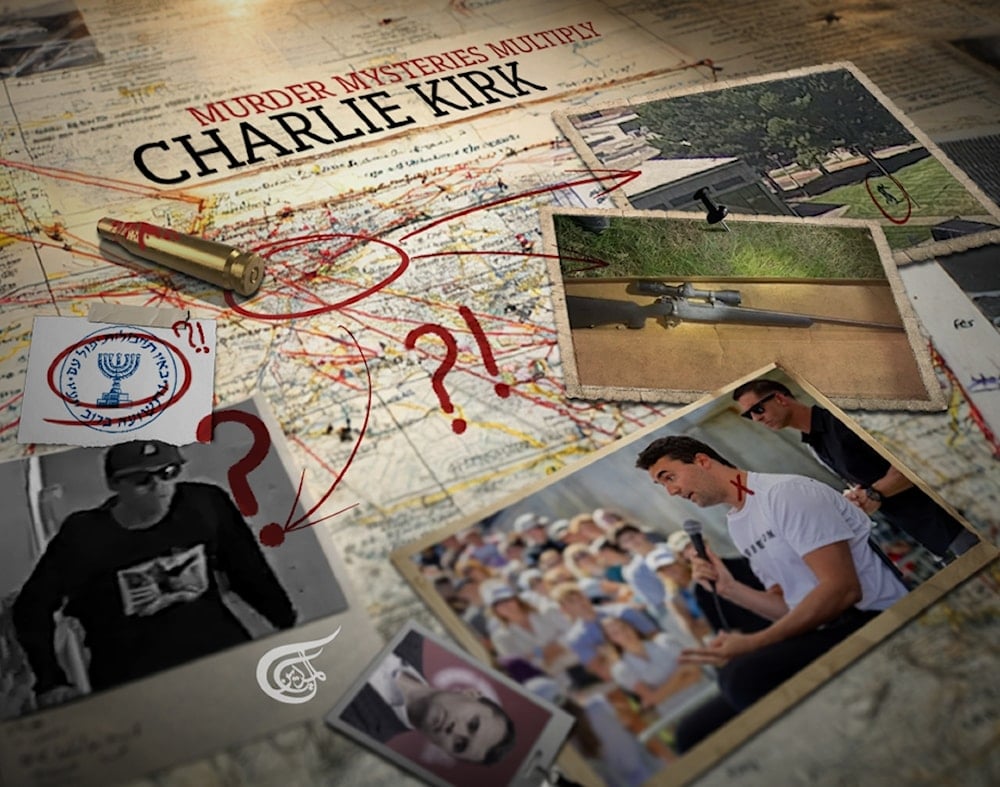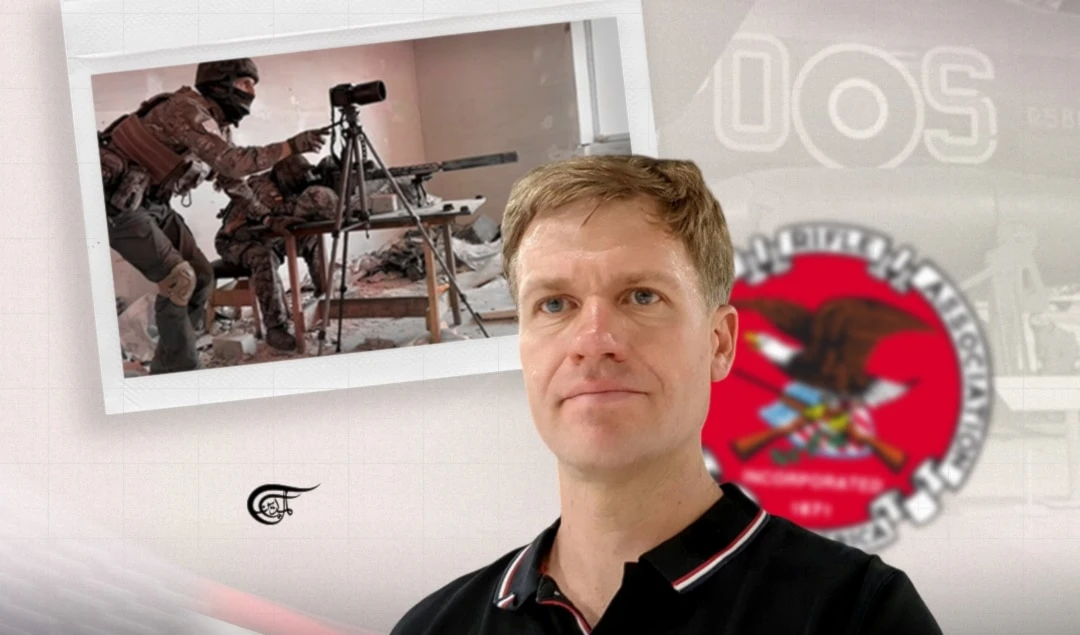Charlie Kirk Murder Mysteries Multiply
The murder of Charlie Kirk remains shrouded in mystery, with doubts about Tyler Robinson’s guilt, questions over security failures, possible insider involvement, and unverified claims of external influence.
-

Charlie Kirk’s September 10 murder raises serious doubts over Tyler Robinson’s guilt, security failures, possible insider involvement, and unexplained evidence inconsistencies (Illustrated by Ali Al-Hadi Chmeis to Al Mayadeen English)
Every day, grave questions and deeply concerning mysteries surrounding the September 10th murder of Turning Point USA chief Charlie Kirk multiply. Per the FBI, the case is open and shut. College dropout Tyler Robinson, an apparent political radical who despised the right-wing activist and influencer for “spreading hate”, seized the opportunity of Kirk’s appearance at Utah Valley University to take him out permanently. While the Bureau and mainstream media have worked overtime to convict Robinson in the court of public opinion, many are unconvinced.
Their doubt is understandable. Robinson turned himself in to the police, as publicly-released photos of Kirk’s alleged killer resembled him and he feared being killed in a SWAT raid on his home. Nonetheless, he denies responsibility, and the assassination scenario posited by authorities - including multiple clothing changes, Robinson leaving his rifle wrapped in a towel in nearby woods for police to find, while dawdling around UVU campus for hours after the shooting despite having the means to immediately flee afterwards in his car - is patently absurd.
What evidence has been released supporting his guilt ranges from woeful to literally non-existent. For example, FBI Director Kash Patel has claimed Robinson wrote a letter confessing to the killing, only for it to be destroyed in uncertain circumstances by persons unknown. Still, “forensic evidence” related to the note apparently somehow confirms its contents. This letter was authored despite Robinson stating in private messages purportedly sent to his roommate and lover that he “had hoped to keep this secret till I died of old age.”
Those exchanges, contained in a publicly-available charging document against Robinson, have been subject to widespread allegations of fakery, and outright mockery. The texts are not replete with time stamps, and appear incongruously self-incriminating for a shooter who allegedly undertook extensive measures to cover his tracks, to the extent that it effectively makes a water-tight case against Robinson on behalf of authorities. Robinson is also quoted using terms such as “squad car” and “drop zone”, among other language, it seems highly improbable a 22-year-old left-winger would employ.
More sinisterly, there is the open question of whether Israel was in any way involved in Kirk’s slaying. While an ardent Zionist for much of his time in the public eye, in the last months of Kirk’s life he began to voice criticism of Tel Aviv’s influence over US politicians, and the threat of Benjamin Netanyahu dragging Washington into war with Iran. In July, a TPUSA conference featured numerous speakers deeply critical of the Zionist entity.
Knowledgeable sources have informed The Grayzone this summit prompted numerous wealthy allies of Netanyahu to bombard Kirk with threatening phone calls and text messages, demanding he correct course and cease platforming anti-Zionist voices. The backlash reportedly left the TPUSA chief feeling “frightened”, and he publicly bemoaned the malign pressure to which he was being subjected in an August 6th interview. Weeks before Kirk’s assassination too, hardline Zionist billionaire Robert Shillman ended his longstanding financial sponsorship of TPUSA.
Concrete proof of Tel Aviv’s culpability for Kirk’s murder is unforthcoming, although one might reasonably enquire why Netanyahu has felt it necessary to issue multiple statements denying the charge. Even hardcore Zionists have cautioned his determination to prove Israel’s innocence smacks of protesting too much. It’s also vital to ask why TPUSA security apparatchiks were responsible for a little-examined litany of catastrophic professional failures on September 10th, leaving Kirk an open, ready target for execution.
‘So Impressive’
The most substantive documentation implicating Tyler Robinson in the shooting is video footage of an individual leaping from the roof of a UVU building directly facing the central campus area where Kirk’s event was held, before making a run for it while lugging a backpack. The FBI and prosecutors charge it was from here Kirk was shot, and the mainstream media has universally accepted this account. A screwdriver, reportedly used to construct and then deconstruct the murder weapon, bearing Robinson’s DNA was allegedly found there.
However, the clip isn’t proof the individual pictured was Robinson, or that they were carrying a rifle. Even more suspiciously, this clip was captured by a static CCTV camera trained directly on the area from where Robinson supposedly targeted Kirk. It was thus perfectly positioned to record him arriving, setting up, assembling the rifle, calibrating its sights, taking the shot, disassembling and camouflaging his weapon, then starting his escape. Bizarrely, no images of this chain of far more incriminating and noteworthy events have emerged.
This deficit can hardly be regarded as inconsequential, given the UVU building’s roof serving as Robinson’s sniper’s nest is absolutely fundamental to the conclusion Kirk was shot from the front. There are other significant problems with this core component of the official narrative. For one, the hole spurting blood that erupted in Kirk’s neck far more resembles an exit rather than an entry wound, strongly suggesting the bullet was fired from elsewhere.
Moreover, if that gory spurt was an entry wound, there should’ve been a massive eruption of blood behind him emanating from an even bigger exit wound - but there was none. Authorities have failed to address or even acknowledge this glaring issue. On September 21st, TPUSA spokesperson Andrew Kolvet attempted to offer an explanation. He relayed how the surgeon who tended to Kirk in the hospital told him the bullet “absolutely should have gone through,” and such a shot “would have taken a moose or two down.”
Yet, in a medically unprecedented “miracle”, Kirk’s “body stopped it”. Kolvet claimed his “bone was [sic] so healthy and the density was so impressive that he’s like the man of steel.” More unbelievably still, a coroner conveniently found the bullet that claimed Kirk’s life lodged “just beneath [his] skin”. This bullet has not to date been presented publicly. There was a camera mounted behind Kirk during the event, which might confirm from which direction he was shot. But what it captured remains another mystery.
‘Main Threat’
In the days following Kirk’s murder, smartphone footage of the shooting’s immediate aftermath began to circulate widely. The video shows that while the crowd had almost fully dispersed, there was virtually zero visible police presence on the ground, or indication of any efforts being undertaken by law enforcement or TPUSA’s security detail to isolate the scene of Kirk’s shooting to prevent evidence being contaminated, degraded or tampered with - quite the reverse, in fact.
An individual wearing dark sunglasses is seen in the clip standing Kirk’s bloodspattered chair upright, then using it as a makeshift stool to remove a camera situated behind where Kirk was sitting. He steps away and removes the memory card, hands it to another person, who then appears to stuff the device into his baseball cap before walking away. The primary individual in question, confirmed to be a TPUSA operative, also removed the memory card from a camera directly facing Kirk.
Both moving Kirk’s chair and removing the camera memory cards represent unambiguous evidence tampering, a serious crime under US federal and state law, for which perpetrators can face prison time and financial penalties. Why capturing those cards was considered an urgent priority for Kirk’s associates isn’t remotely clear. There is no indication that the TPUSA operative responsible is wanted for questioning by authorities, let alone that he will be punished for his actions. This is despite even more suspect footage of the as-yet-unnamed individual subsequently emerging.
The clip shows Kirk’s security team rushing him to an SUV parked behind his speaking spot following the shooting, and bystanders racing after them to safety. Incredibly, the TPUSA operative who subsequently interfered with the crime scene can be spotted perched on a wall filming the chaos below, as if he was already in position before Kirk was shot, and knew precisely what was about to happen. He then moved to capture the memory cards.
The degree of professionalism exhibited by the TPUSA operative in both seemingly situating himself preemptively to ideally capture the dramatic scenes instantly following Kirk’s assassination, and swiftly moving to seize and spirit away crucial evidence before police investigators arrived on the scene, starkly contrasts with the apparent incompetence of TPUSA’s security detail, and UVU’s own. Just six campus police officers were deployed to oversee the event, which attracted around 3,000 people.
Attendees testify that UVU implemented no formal entry gates for the event, their bags weren’t searched, and there was no indication that nearby rooftops or buildings were being monitored for suspicious activity. These literally fatal failings have been harshly condemned by US Secret Service veterans, with particular criticism reserved for the decision to hold the event outdoors, which UVU claims was specifically requested by TPUSA representatives. Kirk’s prior public appearances had invariably been subject to intensive security measures.
On September 2nd, Kirk gave his penultimate rally in Visalia, California. Held indoors, 60 officers were deployed for a crowd of 2,000. Clear restrictions were in place on what attendees could have in their possession, including signs. Over the preceding days, local law enforcement conducted wide-ranging reconnaissance in preparation, researching spots of interest to prospective shooters, and identifying locals ill-disposed to Kirk. On the day itself, both police drones and officers closely monitored his movements to and from the venue, scouting nearby rooftops.
Commenting on the rank professional blunders that supposedly facilitated Kirk’s assassination, Greg Shaffer, who headed TPUSA’s protection detail 2015 - 2022, suggested Kirk’s security team may have erroneously focused exclusively “on threats coming from a much closer distance” rather than a sniper, as “the main threat” had “always” been “somebody getting in the inner circle and attacking Charlie.” Shaffer’s remarks might be more illuminating than he intended - for “somebody” certainly could have infiltrated Kirk’s “inner circle”, explicitly to clear a path for his execution.

 Kit Klarenberg
Kit Klarenberg
 10 Min Read
10 Min Read









